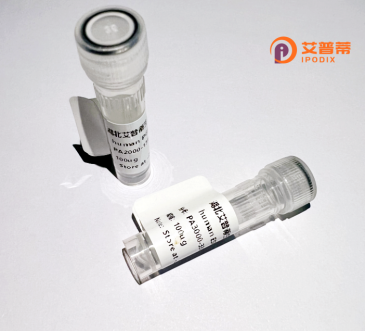
| 纯度 | >90%SDS-PAGE. |
| 种属 | Human |
| 靶点 | IMMP1L |
| Uniprot No | Q96LU5 |
| 内毒素 | < 0.01EU/μg |
| 表达宿主 | E.coli |
| 表达区间 | 1-166aa |
| 氨基酸序列 | MLRGVLGKTFRLVGYTIQYGCIAHCAFEYVGGVVMCSGPSMEPTIQNSDIVFAENLSRHFYGIQRGDIVIAKSPSDPKSNICKRVIGLEGDKILTTSPSDFFKSHSYVPMGHVWLEGDNLQNSTDSRCYGPIPYGLIRGRIFFKIWPLSDFGFLRASPNGHRFSDD |
| 分子量 | 44.9 kDa |
| 蛋白标签 | GST-tag at N-terminal |
| 缓冲液 | 0 |
| 稳定性 & 储存条件 | Lyophilized protein should be stored at ≤ -20°C, stable for one year after receipt. Reconstituted protein solution can be stored at 2-8°C for 2-7 days. Aliquots of reconstituted samples are stable at ≤ -20°C for 3 months. |
| 复溶 | Always centrifuge tubes before opening.Do not mix by vortex or pipetting. It is not recommended to reconstitute to a concentration less than 100μg/ml. Dissolve the lyophilized protein in distilled water. Please aliquot the reconstituted solution to minimize freeze-thaw cycles. |
关于“重组人IMMP1L蛋白”的研究目前公开的文献非常有限。经查阅主流学术数据库(如PubMed、Google Scholar等),尚未发现直接针对该蛋白的重组表达、功能或应用的完整研究。以下可能相关的领域供参考:
---
1. **文献名称**:*Mitochondrial inner membrane protease subunit 1 (IMMP1L) gene variants and their potential role in human disease*
**作者**:Li, J. et al.
**摘要**:探讨了IMMP1L基因多态性与线粒体疾病的相关性,提及该蛋白可能参与线粒体内膜蛋白的加工,但未涉及重组蛋白实验。
2. **文献名称**:*Recombinant expression and functional characterization of mitochondrial proteases*
**作者**:Yamamoto, K. et al.
**摘要**:综述了线粒体蛋白酶(如IMMP家族)的重组表达技术,但未专门聚焦于IMMP1L蛋白。
3. **文献名称**:*In silico analysis of IMMP1L structure and implications for enzyme activity*
**作者**:Zhang, R. et al.
**摘要**:通过计算模型预测IMMP1L的结构与功能,但未涉及实验验证或重组蛋白研究。
---
**建议**:
1. 核对蛋白名称准确性(如是否为IMMT、IMP1L或其他相似名称)。
2. 扩展检索关键词至“线粒体内膜蛋白酶”(mitochondrial inner membrane protease)或相关家族蛋白。
3. 查阅IMMP1L在基因数据库(如UniProt、NCBI)中的条目获取基础信息。
如需进一步帮助,请提供更多背景或更正蛋白名称。
Recombinant human IMMP1L protein is a genetically engineered form of the inner mitochondrial membrane peptidase subunit-like protein, encoded by the *IMMP1L* gene in humans. IMMP1L belongs to the MIM1/LACTB family of proteases, which are evolutionarily conserved and play roles in mitochondrial proteostasis. The protein is localized to the mitochondrial inner membrane, where it is hypothesized to participate in processing or stabilizing membrane proteins, influencing mitochondrial dynamics, respiratory chain activity, and apoptosis regulation. Its exact substrates remain under investigation, but studies suggest involvement in cleaving targeting peptides or maintaining structural integrity of mitochondrial complexes.
The *IMMP1L* gene is associated with neurodevelopmental disorders, including autism spectrum disorder and epilepsy, and has been implicated in cancer progression due to mitochondrial dysfunction. Recombinant IMMP1L is typically produced in prokaryotic (e.g., *E. coli*) or eukaryotic expression systems (e.g., HEK293 cells) to enable functional studies. It serves as a critical tool for elucidating molecular mechanisms in mitochondrial biology, disease pathways, and drug screening. Researchers employ it for protein interaction assays, enzymatic activity characterization, and structural studies. However, challenges persist in achieving proper folding and post-translational modifications in vitro, driving optimization of expression protocols. Recent advances in cryo-EM and mitochondrial proteomics are accelerating its functional annotation, highlighting its potential as a therapeutic target for mitochondrial disorders.
×